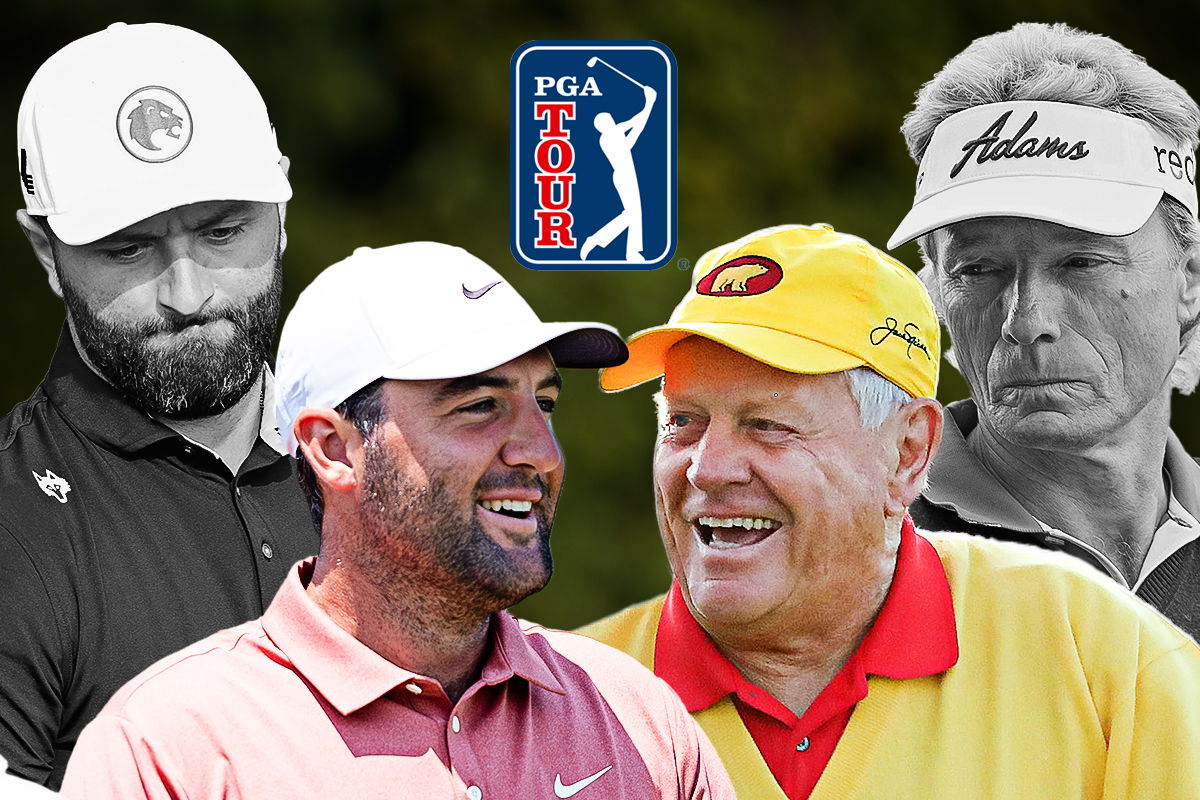

In February 2024, the PGA Tour Enterprise introduced the Equity Program that rewarded golfers for their loyalty to the league. Or that’s what it seemed at first. The program promised a huge purse rising to $930 million, with the top golfers getting a huge chunk. On paper, that should have been a moment of celebration for every golfer representing the PGA Tour. But reality was far from it, as it caused further division among the ranks.
Watch What’s Trending Now!
The PGA Tour’s pursuit to keep its top players may have put them in hot water. That’s because not everyone on the field will benefit from the lucrative opportunity. The structure of the PGA Tour’s Equity Split will give us a clearer picture of how the $930 million is distributed among the talent.
Top Stories
LIV Golf Braces for Another Possible Exit in Wake of Brooks Koepka Departure

Rory McIlroy Makes Feelings Clear on Bryson DeChambeau’s PGA Tour Return: ‘Have Lost…’

Amanda Balionis Confirms New Relationship Ending Months of Rumors

Bryson DeChambeau Gives Reality Check to Phil Mickelson When Asked to Select His Mount Rushmore for Golf

After Brooks Koepka, Another Pro Cuts All Ties With LIV Golf & Publicly Backs PGA Tour

ADVERTISEMENT
PGA Tour Equity Split segregation
With nearly a billion dollars at stake, the PGA Tour Equity Split has not considered every golfer in the current setup to get rewarded for their efforts. The rewards are based on the duration of loyalty and the value they add to the organization. Having said that, the PGA Tour has split the segregation into 4 primary groups.
Group 1
This group features the biggest and the best the PGA Tour has to offer. It consists of Tiger Woods, Rory McIlroy, Jordan Spieth, Justin Thomas, etc. They each get a part of the $750 million that is allotted to the top 36 golfers on the FedEx Cup leaderboard in group 1. The results also take into account career performances, the last five years’ form, and PIP rankings.
ADVERTISEMENT
Group 2
Completing the remaining 100, this list consisted of the next 64 FedEx Cup-ranked golfers in the list. Apart from the ranking requirements, the performance data is also limited to 3 years old. In the end, a $75 million purse is split between the 64 golfers enlisted in this group.
ADVERTISEMENT
Group 3
Beyond the top 100, anyone who has earned their PGA Tour membership and is ranked on the FedEx Cup leaderboard from 101 to 157 is eligible for a $30 million split. Rickie Fowler, Brian Campbell, and Luke Clanton will probably join that list this year. The only qualification criterion is a full exemption from the PGA Tour events.
ADVERTISEMENT
Group 4
Paying respect to the senior golfers in the PGA Tour, the board decided to hand the top 36 legends lucrative paychecks as well. Matching the deals for group 2, the best legends will get a $75 million split among them for their continued impact. All they need to do is continue making appearances.
The last group did more harm than good for the PGA Tour. They were expecting the senior golfers to be more appreciative of the opportunity. But after reading the fine print, it’s evident to them that the board is only trying to juice them out even further.
The PGA Tour is forcing the 36 legends that got equity in their new Player Equity Program to do "as many as 40 sponsor activities (5 per year) to be fully vetted" for their equity. Unless, they can play a total of 15 events per year on either the regular or Champions Tour.
— JCAGOLFReport (@JCAGOLFReport) July 2, 2025
ADVERTISEMENT
The seniors have to compete in 5 sponsored events or 15 other events per year. Only then can they get their paychecks. They have the option to play both the PGA Tour and the Champions Tour to complete this feat. That’s not the only unfair bit.
As the rules for group 1 state, golfers will need 5 years of continued success to qualify for equity allocation. Moreover, the equity split also includes an 8-year vesting schedule. 50% of the rewards are accumulated after 4 years, 75% after 6, and 100% by the 8th year. Clauses within the program also allow former LIV Golf players who return to the PGA Tour to benefit from the program.
While big names like Woods and McIlroy may have booked their ticket, the likes of Scottie Scheffler, Viktor Hovland, and Ludvig Aberg will have to remain consistent for a few more years before they can benefit from the program. As John Nucci put it, the PGA Tour equity split program is “a formula weighted to the past.” However, it will benefit the golfers in the long run if they remain patient.
ADVERTISEMENT
Such regulations definitely benefit the big names. For example, Tiger Woods, being the most impactful golfer over the past decade, will earn the biggest paycheck of $100 million. Rory McIlroy, who has also been quite impactful, will get $50 million for his efforts over the last 8 years. The strategy will only make the rich even richer and take the spotlight away from the other golfers.
On the other end, younger, more promising golfers who will drive the future of the PGA Tour will find this discouraging. They will have to always compete with the legacy to win big through this PGA Tour program. And even then, the likes of Luke Clanton will need to wait at least 8 years since the start of making an impact to benefit from the equity split. This definitely won’t encourage the future of the PGA Tour.
Interestingly, the PGA Tour Enterprise has already decided a few things regarding the group segregation. And that has received a lot of backlash.
ADVERTISEMENT
Group choices have caused chaos
While some of the group choice criteria were straightforward, the legends category remained highly subjective. Golf has produced innumerable legends over the years. For the Enterprise to pick only 36 would have always created a lot of trouble for them. Those who missed the list raised their voices, looking for explanations from the PGA Tour branch. The likes of Bernhard Langer, Sir Nick Faldo, Padraig Harrington, and a few others were all excluded from the 36 legends list. Despite being multi-time major winners, they were not considered impactful enough to be included in the $75 million payout.
Faldo shared his displeasure with the entire situation. Speaking about not being selected and his interaction with Jay Monahan about it, he said, “I was disappointed that Jay couldn’t man up and call me personally. The letter basically said I haven’t played enough and won enough. I guess we were in the wrong era. I’d like to think my contributions to the Tour were significant enough. Plus, I did 18 years of TV, and I don’t think I ever said a bad word about the Tour, and I supported Jay through LIV.” While the PGA Tour Enterprise may have a valid reason for not choosing him, for Monahan not to even respond is quite disrespectful.
ADVERTISEMENT
While legends who didn’t make the list did speak up about it, it’s still not clear who is a part of Group 4. The fact is, the PGA Tour hasn’t revealed the list of 36 players who will receive the benefits. The opaque nature of the situation raises further questions about the authenticity of the equity split program. And fans have started questioning its purpose.
Speaking about the dodgy nature of the deal, one of the fans mentioned, “I don’t see most of these older guys caring about that equity enough to become mouthpieces. Couples is 66; he’s gonna play when he feels like playing; he’s earned that right. I’m sure many of the others feel the same.” They seem to believe that experienced veterans like Fred Couples don’t require the additional benefits to push themselves into such a situation with the PGA Tour.
Another fan wrote, “The guy who took the biggest slice of this equity pie definitely doesn’t play 15 times a year, and I’m pretty sure they won’t be making him do a certain number of appearances 🐅.” Their comment was directed towards Tiger Woods, who has certainly not played often in recent years. However, his impact off the course is large enough that he still moves the needle every time he is present. TaylorMade videos featuring Woods are prime examples of the same, as they usually get far more views than any other content produced by them.
The PGA Tour equity split program has a lot to offer for golfers who know they have the potential to be the best on the Tour. And it may technically align with a performance-and-loyalty narrative, but it also freezes money into dynasties, alienates both past and future generations, and overplays secrecy over merit. It risks fracturing more than uniting.
ADVERTISEMENT
ADVERTISEMENT
ADVERTISEMENT

